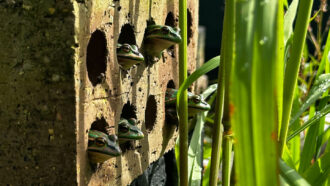
Space
Is the International Space Station too clean?
Testing surfaces on board the space station revealed low microbial diversity, something that’s been linked to health problems elsewhere.
Come explore with us!

Testing surfaces on board the space station revealed low microbial diversity, something that’s been linked to health problems elsewhere.

These microbes can break the carbon bonds that make PET plastics so hard to degrade. This type of plastic makes up almost one-third of plastic waste.

Made from white flour and formic acid, the nanofibers average just 370 nanometers across. That’s two-hundredths the thickness of a human hair.

A hulking marine cyanobacterium, Chonkus has traits that appears to make it especially good for storing away carbon on the ocean floor.

The bodies of most animals keep germs, usually linked to disease, out of their brains. But some fish that host microbes seem to do just fine.

Sally Warring has long been captivated by the beauty of mostly single-celled life forms called protists.

The newfound strategy seen in C. matruchotii might help oral bacteria recover lost territory after each eviction by toothbrushing.

More than 30 microwave ovens were sampled in a range of different settings. The microbes in them included ones that can cause food poisoning in people.

The robot examined a Mars rock containing organic compounds and “leopard spots.” On Earth, such spots usually come from microbial life.

Hanging out in small sun-warmed hideaways could help some frogs resist deadly chytrid fungus, a new study finds.